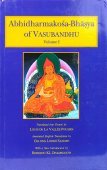Samgitiparyaya, Saṃgītiparyāya, Saṅgītiparyāya, Samgiti-paryaya, Sangiti-paryaya, Sangitiparyaya: 4 definitions
Introduction:
Samgitiparyaya means something in Buddhism, Pali, Hinduism, Sanskrit. If you want to know the exact meaning, history, etymology or English translation of this term then check out the descriptions on this page. Add your comment or reference to a book if you want to contribute to this summary article.
In Buddhism
Mahayana (major branch of Buddhism)
Source: Wisdom Library: Maha Prajnaparamita SastraSaṃgītiparyāya (संगीतिपर्याय) by Mahākauṣṭhila refers to one of the six parts of the Ṣaṭpādābhidharma which is the Jñānaprasthāna and the six annexed treatises that are its continuation (anucāra) or ‘feet’ (cf. Kośa, I, p. 4, n. 4). There is a list of them in Sanskrit in the Kośavyākhyā, p. 9, and in Tibetan in Buston, I. p. 49 and Taranātha, p. 296. [...] Along with the Jñānaprasthāna, these are the seven treatises of the Sarvāstivādin Abhidharma. [...]

Mahayana (महायान, mahāyāna) is a major branch of Buddhism focusing on the path of a Bodhisattva (spiritual aspirants/ enlightened beings). Extant literature is vast and primarely composed in the Sanskrit language. There are many sūtras of which some of the earliest are the various Prajñāpāramitā sūtras.
Languages of India and abroad
Sanskrit dictionary
Source: Cologne Digital Sanskrit Dictionaries: Edgerton Buddhist Hybrid Sanskrit DictionarySaṃgītiparyāya (संगीतिपर्याय).—(Pali °pariyāya; compare also Saṃgīta- nipāta), m., name of a work: Mahāvyutpatti 1416; = Tibetan ḥgro, or bgro, baḥi rnam graṅs; read bgro, discuss or the like, see saṃgīti (2), on Saddharmapuṇḍarīka 286.7; Takakusu, JPTS 1904—5, p. 99. Frag- ments of Saṃgīti-sūtra, Hoernle [Manuscript Remains of Buddhist literature found in Eastern Turkestan] 16 ff.
Source: Cologne Digital Sanskrit Dictionaries: Monier-Williams Sanskrit-English DictionarySaṃgītiparyāya (संगीतिपर्याय):—[=saṃ-gīti-paryāya] [from saṃ-gīti > saṃ-gai] m. Name of a Buddhist [work]
[Sanskrit to German]
Sanskrit, also spelled संस्कृतम् (saṃskṛtam), is an ancient language of India commonly seen as the grandmother of the Indo-European language family (even English!). Closely allied with Prakrit and Pali, Sanskrit is more exhaustive in both grammar and terms and has the most extensive collection of literature in the world, greatly surpassing its sister-languages Greek and Latin.
See also (Relevant definitions)
Partial matches: Samgiti, Paryaya.
Full-text: Samgitanipata, Punyakriyavastu, Shatpadabhidharma, Anagamin, Samgiti.
Relevant text
Search found 2 books and stories containing Samgitiparyaya, Saṃgītiparyāya, Saṅgītiparyāya, Samgiti-paryaya, Sangiti-paryaya, Sangitiparyaya, Saṃgīti-paryāya, Saṅgīti-paryāya; (plurals include: Samgitiparyayas, Saṃgītiparyāyas, Saṅgītiparyāyas, paryayas, Sangitiparyayas, paryāyas). You can also click to the full overview containing English textual excerpts. Below are direct links for the most relevant articles:
Maha Prajnaparamita Sastra (by Gelongma Karma Migme Chödrön)
Appendix 3 - Five kinds of Anāgāmin (non-returners) < [Chapter XLIX - The Four Conditions]
I.2. Pure and impure generosity (dāna) < [I. Puṇyakriyāvastu consisting of generosity]
Preliminary note (2): The dvādaśāṅga < [Part 2 - Hearing the twelve-membered speech of the Buddha]
A Dictionary Of Chinese Buddhist Terms (by William Edward Soothill)
Related products
